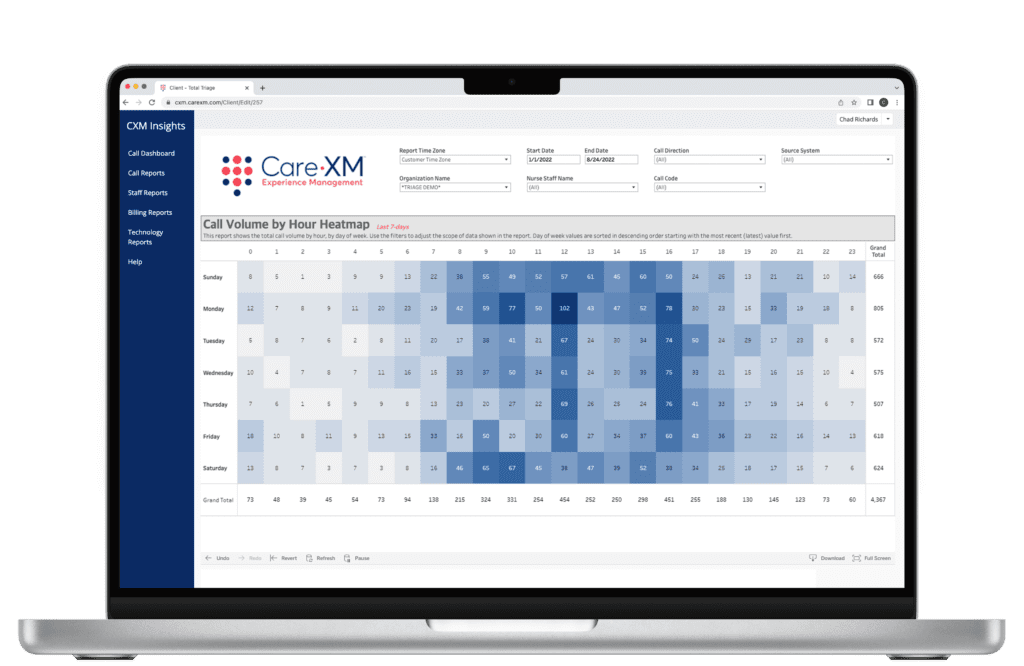
The holiday season often brings unique challenges for home health and hospice agencies, particularly when it comes to managing after-hours triage. With regular staffing reduced due to holiday schedules, the influx of patient needs, and increased after-hours calls, even the most efficient systems can become strained.
Patients and their families may require more attention during this time as urgent medical issues can arise when regular office hours are closed. To protect the care continuum and avoid staff burnout, agencies must explore strategies for efficiently managing after-hours triage during the holiday season and ensuring patients and caregivers receive the support they need.
Holiday After-Hours Triage: Understanding and Anticipating Demand
For most healthcare providers, holidays lead to a surge in patient needs and after-hours calls. This is usually driven by activities like high travel, family gatherings, and the flux of seasonal illnesses. Patients also tend to experience more acute health issues due to the elevated stress of holiday activities, while others might face complications from being away from their usual care environment.
A great way to manage this heightened demand is for agencies to look at data from previous holiday seasons so that providers can confidently make better staffing decisions and efficiently allocate holiday resources.
CareXM’s one-of-a-kind provides consistent and reliable after-hours data, helping providers accurately pinpoint staffing gaps, call volume peaks, and patient needs. Armed with data, providers can anticipate patient needs and address them proactively during the day, so there are fewer calls after hours. When paired with a coordinated after-hours triage service, your staff has helped manage increased call volume with expert triage nurses during the holidays, reducing strain on your staff while maintaining high-quality patient care.

Optimizing After-Hours Triage Staff: Scheduling and Coverage
Data is essential for optimizing staffing schedules during the holiday season. Access to detailed call data and analytics helps agencies identify peak times so providers can deploy flexible schedules that include part-time, per diem, or staggering on-call staff to fill in as needed.
Cross-training non-clinical staff to handle multiple roles can also address unexpected surges in patient needs, ensuring that the clinical team can focus on care and provide coverage even when call volumes are higher than anticipated. Clear communication about holiday schedules, shared generously in advance, helps prevent confusion, last-minute cancellations, or unplanned gaps in coverage.
However, even the most well-structured plans can encounter challenges. When after-hours staff is overwhelmed, having a backup triage service can make all the difference. Partnering with a service that integrates seamlessly with existing technology ensures no call goes unanswered, maintaining quality care and easing the workload on in-house teams.

Leveraging Technology for Efficient After-Hours Triage
Technology can be a game-changer for managing after-hours triage during the holiday season. Tools like telehealth, virtual visits, and automated patient engagement platforms allow staff to address patient needs remotely and proactively, reducing the need for in-person visits while expanding clinician capacity. These virtual care technologies help triage nurses quickly assess patients’ concerns, offer guidance, and free up visit nurses to handle patient needs that truly require hands-on care.
Mobile apps and digital communication platforms, such as the Care Coordination Platform and CareXM mobile app, make after-hours triage more efficient. Features like secure messaging enable real-time coordination between triage nurses, while automatic call routing expands untapped clinician capacity to answer calls so nurses can focus on care instead of answering calls. These tools streamline and facilitate seamless communication between staffing teams, creating a faster response during peak holiday periods.
Enhancing Communication Protocols
Clear and consistent communication is key for effective after-hours triage, especially during the holiday season. Implementing standardized triage protocols helps streamline decision-making and reduce the risk of errors, allowing backup triage nurses to provide timely and appropriate care during high-stress periods as a seamless extension of provider care teams, no matter the situation.
Regular communication between the triage team and the primary care team is also crucial to maintaining seamless care. By integrating after-hours activity with EMRs, organizations can cut down on unnecessary workloads, provide staff with easy access to patient updates, and keep care smooth and uninterrupted.

Supporting Staff and Preventing Burnout
The holiday season can be tough for home health and hospice staff, as increased caregiver demand and limited coverage raise the risk of burnout, not to mention fatigue and errors. With more after-hours calls and patient needs to address, it’s essential to support and prioritize staff well-being.
To prevent burnout, ensure staff have adequate breaks and access to mental health resources like counseling services or stress management programs. Recognizing and rewarding hard work through bonuses and public acknowledgment can also help.
Most of all, delivering real work-life balance using care coordination technologies and an on-demand, flexible after-hours triage service can give staff more real off time, allowing them to rest without the constant pressure of being on call. Supporting staff well-being helps maintain a positive work environment and ensures high-quality care during the holiday season.
Proactive, Automatic Support for Patients and Families
To further reduce stress, expand clinician capacity, and improve patient outcomes during the holidays, providers can use automated patient engagement tools. Automatic check-ins and on-the-go surveys can find out if patients need medication refills or have changing symptoms before holiday breaks, when staffing is more limited.
Distributing educational materials about a patient’s conditions, what to expect during hospice care, or even common holiday health risks can empower patients and families. CareXM’s patient engagement tools offer a library of ready-to-use content, making it easy to share these helpful tips.
Consider setting up a dedicated holiday hotline or information center using AVA (Automated Voice Assistant) to handle non-urgent issues, provide quick answers, and reduce distractions for triage staff so they can focus on direct patient care. By offering proactive care and educational resources, agencies can further lower call volumes and boost patient confidence in their care during the holiday season while relieving already stressed after-hours triage teams.
Manage Your Holiday After-Hours Triage with CareXM
Successfully managing after-hours triage during the holiday season requires careful planning, efficient staffing, and the right technology. By anticipating increased demand, leveraging telehealth and secure communication platforms, and prioritizing staff well-being, home health and hospice agencies can maintain a high standard of care even during the busiest times.
CareXM is the premier partner for streamlining after-hours triage during the holiday season. With advanced tools like CareXM’s triage coordination technology, virtual visits, and patient engagement solutions, you can ensure that your patients receive the support they need while your staff provides quality, stress-free care. Make this holiday season smoother for your agency with CareXM’s reliable and efficient after-hours triage services.